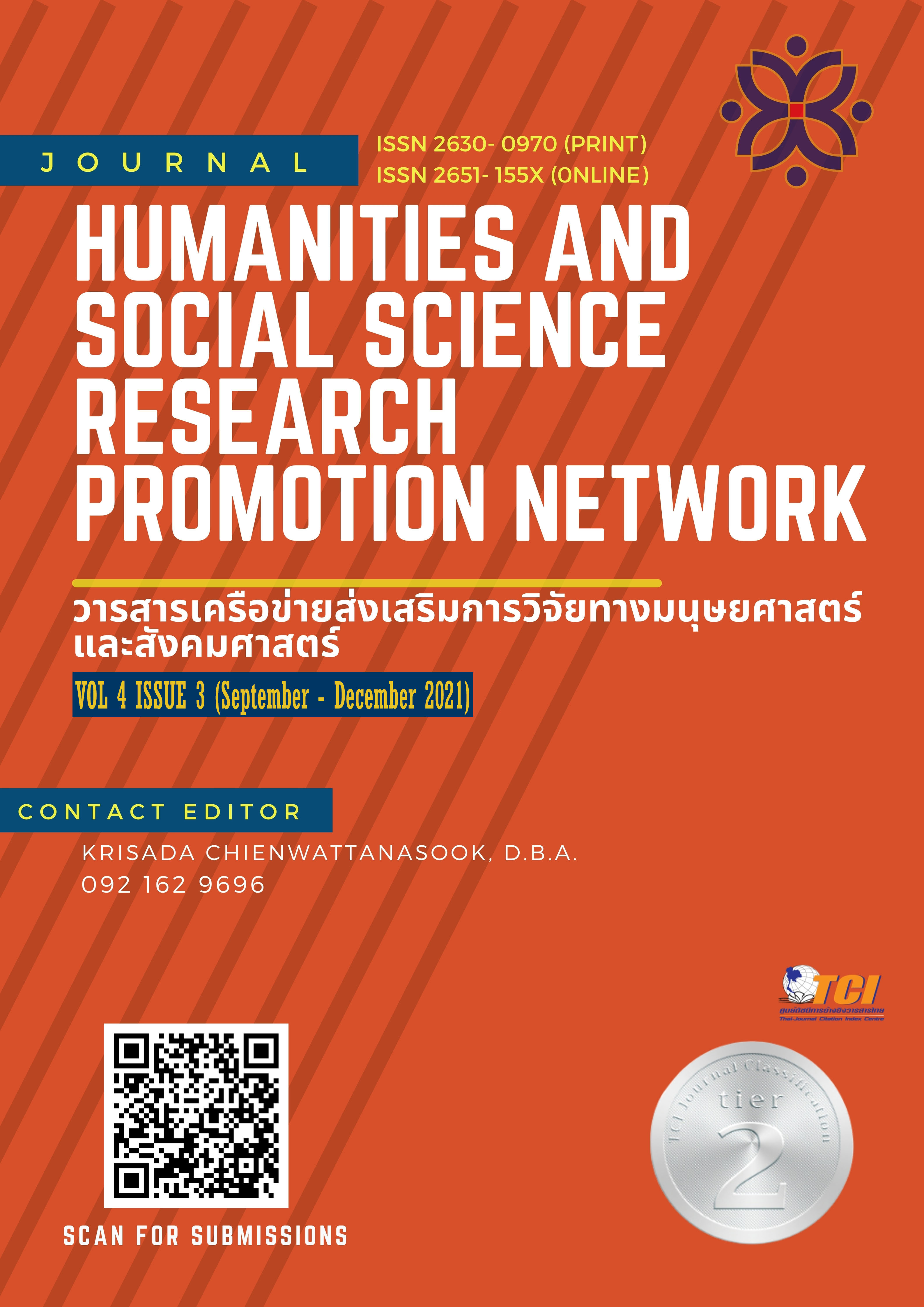อิทธิพลของมาตรฐานไมซ์ที่มีต่อประสิทธิภาพของโรงแรม และบทบาทของตัวแปรคั่นกลางของโครงสร้างองค์กร
คำสำคัญ:
มาตรฐานไมซ์, โครงสร้างองค์กร, ประสิทธิภาพของโรงแรม, โรงแรมไมซ์บทคัดย่อ
งานวิจัยเรื่องนี้มีวัตถุประสงค์ คือ เพื่อสำรวจอิทธิพลของมาตรฐานไมซ์ที่มีต่อประสิทธิภาพของโรงแรมและบทบาทของตัวแปรคั่นกลางของโครงสร้างองค์กร (องค์กรแบบกลไกและองค์กรแบบออร์แกนิก) การศึกษาวิจัยครั้งนี้เป็นการวิจัยเชิงปริมาณ โดยรวบรวมข้อมูลจากพนักงานโรงแรม 416 คน ตั้งแต่ฝ่ายปฏิบัติการไปจนถึงผู้บริหารระดับสูง ที่เกี่ยวข้องกับการดำเนินงานตามกลยุทธ์ไมซ์ในประเทศไทย วิธีการวิจัยเชิงปริมาณใช้ในตรวจสอบตัวแปรและทดสอบสมมติฐาน ศึกษาความสัมพันธ์โดยใช้แบบจำลองสมการโครงสร้าง (SEM) ผลการวิจัยพบว่ามาตรฐานไมซ์มีความสัมพันธ์เชิงบวกกับโครงสร้างองค์กร ผลลัพธ์ยังแสดงให้เห็นถึงความสัมพันธ์เชิงบวกระหว่างโครงสร้างองค์กรและผลการดำเนินงานของโรงแรม อย่างไรก็ตาม ไม่พบผลกระทบโดยตรงของมาตรฐานไมซ์ต่อประสิทธิภาพโรงแรม โครงสร้างองค์กรจึงมีบทบาทเป็นตัวกลางในความสัมพันธ์ระหว่างมาตรฐานไมซ์กับผลการปฏิบัติงานของโรงแรม แสดงว่าผลศึกษาของงานวิจัย
ในอุตสาหกรรมไมซ์ที่มีนัยสำคัญทางสถิติ
เอกสารอ้างอิง
Allen, R. S., & Helms, M. M. (2006). Linking strategic practices and organizational performance to Porter's generic strategies. Business Process Management Journal, 12(4), 433-454.
Burns, T., & Stalker, G. M. (1961). Mechanistic and organic systems. Classics of organizational theory, 209-214.
Covin, J. G., & Slevin, D. P. (1988). The influence of organization structure on the utility of an entrepreneurial top management style. Journal of Management Studies, 25(3), 217-234.
Dubé, L., & Renaghan, L. M. (1999). Building Customer Loyalty— Guests' Perspectives on the Lodging Industry's Functional Best Practices (Part I). Cornell Hotel and Restaurant Administration Quarterly, 40(5), 78-88.
Fitz-Enz, J. (2010). The new HR analytics. American Management Association.
Fornell, C., & Larcker, D. F. (1981). Evaluating structural equation models with unobservable variables and measurement error. Journal of Marketing Research, 18(1), 39-50.
Hair, J. F. J., Black, W. C., Babin, B. J., & Anderson, R. E. (2010). Multivariate Data Analysis (7th ed.). NJ: Prentice Hall.
Jogaratnam, G., & Tse, E. C. Y. (2006). Entrepreneurial orientation and the structuring of organizations: performance evidence from the Asian hotel industry. International Journal of Contemporary Hospitality Management, 18(6), 454-468.
Kanten, P., Kanten, S., & Gurlek, M. (2015). The effects of organizational structures and learning organization on job embeddedness and individual adaptive performance. Procedia Economics and Finance, 23, 1358-1366.
Maitha, O., & Wang'oe, R. (2013). The Effect of Formal Organizational Structures on Inter-organizational Networks: A study on OEMs in the forest technology industry of Northern Sweden. (Master's program in Business Development and Internationalisation, Umeå School of Business and Economics).
Mallén, F., Chiva, R., Alegre, J., & Guinot, J. (2016). Organicity and performance in excellent HRM organizations: the importance of organizational learning capability. Review of Managerial Science, 10(3), 463-485.
Murasiranwa, E., Nield, K., & Ball, S. (2010). Hotel Service Quality and Business Performance in five hotels belonging to a UK Hotel Chain. International CHRIE Conference-Refereed Track, 11. http://scholarworks.umass.edu/refereed/CHRIE_2010/Wednesday/11
Nunnally, J. C. (1978). Psychometric theory. NY: McGraw-Hill.
Okumus, F., Altinay, L., & Chathoth, P. (2010). Strategic management in the international hospitality and tourism industry. Elsevier, Oxford.
Porter, M. E. (1980). Industry structure and competitive strategy: Keys to profitability. Financial Analysts Journal, 36(4), 30-41.
Preacher, K. J., & Hayes, A. F. (2008). Asymptotic and resampling strategies for assessing and comparing indirect effects in multiple mediator models. Behavior Research Methods, 40(3), 879-891.
Schaffer, J. D., & Litschert, R. J. (1990). Internal consistency between strategy and structure: Performance implications in the lodging industry. Hospitality Research Journal, 14(1), 35-53.
TCEB. (2015). 2015 Perspectives on MICE industry in ASEAN. MICE journal, 1, 7.
Tse, Y. K. (1991). Stock returns volatility in the Tokyo Stock Exchange. Japan and the World Economy, 3(3), 285-298.
Wilden, R., Gudergan, S. P., Nielsen, B. B., & Lings, I. (2013). Dynamic capabilities and performance: strategy, structure and environment. Long Range Planning, 46(1-2), 72-96.
Zheng, W., Yang, B., & McLean, G. N. (2010). Linking organizational culture, structure, strategy, and organizational effectiveness: Mediating role of knowledge management. Journal of Business Research, 63(7), 763-771.
ดาวน์โหลด
เผยแพร่แล้ว
รูปแบบการอ้างอิง
ฉบับ
ประเภทบทความ
สัญญาอนุญาต
บทความที่ได้รับการตีพิมพ์เป็นลิขสิทธิ์ของ ผู้เขียน
ทัศนะและความคิดเห็นที่ปรากฏในบทความในวารสารเครือข่ายส่งเสริมการวิจัยทางมนุษยศาสตร์และสังคมศาสตร์จะถือเป็นความรับผิดชอบของผู้เขียนบทความนั้น และไม่ถือเป็นทัศนะและความรับผิดชอบของกองบรรณาธิการ








